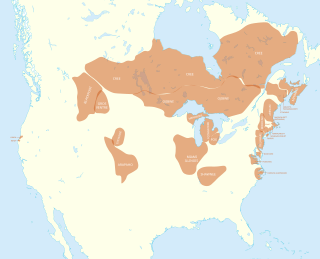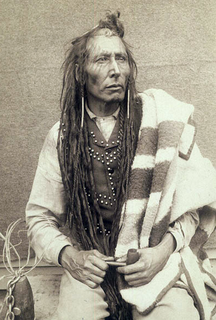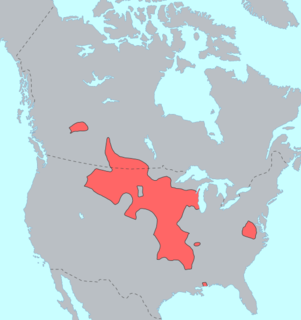 W
WThe Algic languages are an indigenous language family of North America. Most Algic languages belong to the Algonquian subfamily, dispersed over a broad area from the Rocky Mountains to Atlantic Canada. The other Algic languages are the Yurok and Wiyot of northwestern California, which, despite their geographic proximity, are not closely related. All these languages descend from Proto-Algic, a second-order proto-language estimated to have been spoken about 7,000 years ago and reconstructed using the reconstructed Proto-Algonquian language and the Wiyot and Yurok languages.
 W
WThe Algonquian languages are a subfamily of American indigenous languages that include most languages in the Algic language family. The name of the Algonquian language family is distinguished from the orthographically similar Algonquin dialect of the indigenous Ojibwe language (Chippewa), which is a senior member of the Algonquian language family. The term Algonquin has been suggested to derive from the Maliseet word elakómkwik, "they are our relatives/allies". A number of Algonquian languages, like many other Native American languages, are now extinct.
 W
WAthabaskan is a large family of indigenous languages of North America, located in western North America in three areal language groups: Northern, Pacific Coast and Southern. Kari and Potter 2010:10 place the total territory of the 53 Athabaskan languages at 4,022,000 square kilometres (1,553,000 sq mi).
 W
WThe Blackfoot language, also called Siksiká, , often anglicised as Siksika, is an Algonquian language spoken by the Blackfoot or Niitsitapi people, who currently live in the northwestern plains of North America. There are four dialects, three of which are spoken in Alberta, Canada, and one of which is spoken in the United States: Siksiká (Blackfoot), to the southeast of Calgary, Alberta; Kainai, spoken in Alberta between Cardston and Lethbridge; Aapátohsipikani, to the west of Fort MacLeod which is Brocket (Piikani) and Aamsskáápipikani, in northwestern Montana. The name Blackfoot probably comes from the blackened soles of the leather shoes that the people wore.
 W
WBungi is a creole language of Scottish English, the Orcadian dialect of Scots, Scottish Gaelic, French, Norn, Cree, and Ojibwe (Saulteaux). It was spoken by the Scottish Red River Métis in present-day Manitoba, Canada.
 W
WThe Cheyenne language, is the Native American language spoken by the Cheyenne people, predominantly in present-day Montana and Oklahoma, in the United States. It is part of the Algonquian language family. Like all other Algonquian languages, it has complex agglutinative morphology. This language is considered endangered, at different levels, in both states.
 W
WComanche is a Uto-Aztecan language spoken by the Comanche people, who split from the Shoshone people soon after the Comanche had acquired horses around 1705. The Comanche language and the Shoshoni language are therefore quite similar, but certain consonant changes in Comanche have inhibited mutual intelligibility.
 W
WCree is a dialect continuum of Algonquian languages spoken by approximately 117,000 people across Canada, from the Northwest Territories to Alberta to Labrador. If considered one language, it is the aboriginal language with the highest number of speakers in Canada. The only region where Cree has any official status is in the Northwest Territories, alongside eight other aboriginal languages. There, Cree is spoken mainly in Fort Smith and Hay River.
 W
WCrow is a Missouri Valley Siouan language spoken primarily by the Crow Nation in present-day southeastern Montana. The word, Apsáalooke, translates to "children of the large beaked bird." It is one of the larger populations of American Indian languages with 2,480 speakers according to the 1990 US Census.
 W
WFox is an Algonquian language, spoken by a thousand Meskwaki, Sauk, and Kickapoo in various locations in the Midwestern United States and in northern Mexico.
 W
WAtsina, or Gros Ventre, was the ancestral language of the Gros Ventre people of Montana. The last fluent speaker died in 2007, though revitalization efforts are underway.
 W
WKarankawa is the extinct, unclassified language of the Texas coast, where the Karankawa people migrated between the mainland and the barrier islands. It was not closely related to other known languages in the area, many of which are also poorly attested, and may have been a language isolate. A couple hundred words are preserved, collected in 1698, 1720, and 1828; in the 1880s, three lists were collected from non-Karankawa who knew some words.
 W
WKiowa or Cáuijògà/Cáuijò:gyà is a Tanoan language spoken by the Kiowa Tribe of Oklahoma in primarily Caddo, Kiowa, and Comanche counties. The Kiowa tribal center is located in Carnegie. Like most North American languages, Kiowa is an endangered language.
 W
WLakota, also referred to as Lakhota, Teton or Teton Sioux, is a Siouan language spoken by the Lakota people of the Sioux tribes. Though generally taught and considered by speakers as a separate language, Lakota is mutually intelligible with the two dialects of the Dakota language, especially Western Dakota, and is considered by most linguists as one of the three major varieties of the Sioux language.
 W
WNumic is a branch of the Uto-Aztecan language family. It includes seven languages spoken by Native American peoples traditionally living in the Great Basin, Colorado River basin, Snake River basin, and southern Great Plains. The word Numic comes from the cognate word in all Numic languages for "person." For example, in the three Central Numic languages and the two Western Numic languages it is. In Kawaiisu it is and in Colorado River, and.
 W
WThe Pawnee language is a Caddoan language spoken by some Pawnee Native Americans who now live in north-central Oklahoma. Their traditional historic lands were along the Platte River in what is now Nebraska.
 W
WThe Plains Apache language was a Southern Athabaskan language formerly spoken by the Plains Apache, organized as the Apache Tribe of Oklahoma, living primarily around Anadarko in southwest Oklahoma. The language is extinct as of 2008, when Alfred Chalepah, Jr., the last native speaker, died.
 W
WPlains Cree is a dialect of the Algonquian language, Cree, which is the most populous Canadian indigenous language. Plains Cree is considered a dialect of the Cree-Montagnais language or a dialect of the Cree language that is distinct from the Montagnais language. Plains Cree is one of five main dialects of Cree in this second sense, along with Woods Cree, Swampy Cree, Moose Cree, and Atikamekw. Although no single dialect of Cree is favored over another, Plains Cree is the one that is the most widely used. Out of the 116,500 speakers of the Cree language, the Plains Cree dialect is spoken by about 34,000 people primarily in Saskatchewan and Alberta but also in Manitoba and Montana.
 W
WSiouan or Siouan–Catawban is a language family of North America that is located primarily in the Great Plains, Ohio and Mississippi valleys and southeastern North America with a few other languages in the east.
 W
WStoney—also called Nakota, Nakoda, Isga, and formerly Alberta Assiniboine—is a member of the Dakota subgroup of the Mississippi Valley grouping of the Siouan languages. The Dakotan languages constitute a dialect continuum consisting of Santee-Sisseton (Dakota), Yankton-Yanktonai (Dakota), Teton (Lakota), Assiniboine, and Stoney.
 W
WThe Tonkawa language was spoken in Oklahoma, Texas, and New Mexico by the Tonkawa people. A language isolate, with no known related languages, Tonkawa has not had L1 speakers since the mid 1900s. Most Tonkawa people now only speak English.
 W
WThe Tsuutʼina language is spoken by the people of the Tsuutʼina Nation, whose reserve and community is near Calgary, Alberta. It belongs to the Athabaskan language family, which also include the Navajo and Chiricahua of the south, and the Dene Suline and Tłı̨chǫ of the north.
 W
WUnami was a Algonquian language spoken by the Lenape people in the late 17th century and the early 18th century, in what then was the southern two-thirds of New Jersey, southeastern Pennsylvania and the northern two-thirds of Delaware, but later in Ontario and Oklahoma. It is one of the two Delaware languages, the other being Munsee. The last fluent speaker in the United States, Edward Thompson, of the Delaware Tribe of Indians, died on August 31, 2002. His sister Nora Thompson Dean (1907–1984) provided valuable information about the language to linguists and other scholars.
 W
WThe Western Siouan languages, also called Siouan proper or simply Siouan, are a large language family native to North America. They are closely related to the Catawban languages, sometimes called Eastern Siouan, and together with them constitute the Siouan (Siouan–Catawban) language family.
 W
WWichita is an extinct Caddoan language once spoken in Oklahoma by the Wichita and Affiliated Tribes. The last fluent heritage speaker, Doris Lamar-McLemore, died in 2016, although in 2007 there were three first-language speakers alive. This has rendered Wichita functionally extinct; however, the tribe offers classes to revitalize the language and works in partnership with the Wichita Documentation Project of the University of Colorado, Boulder.